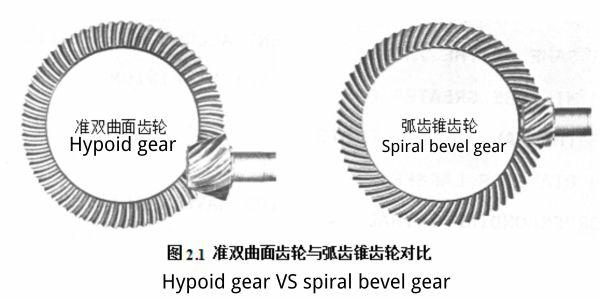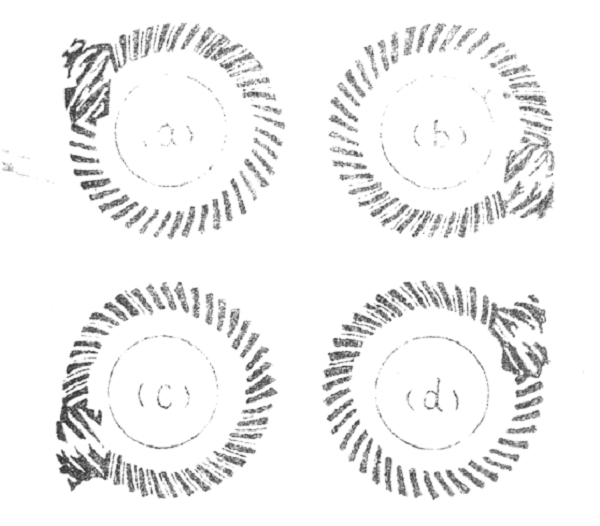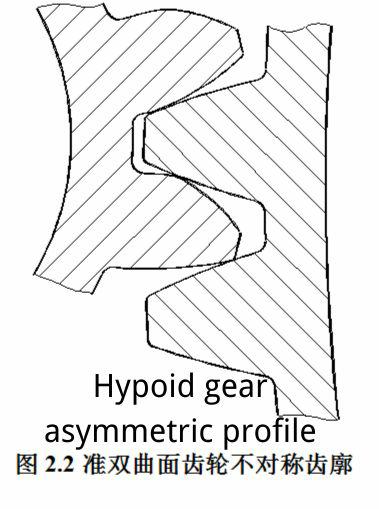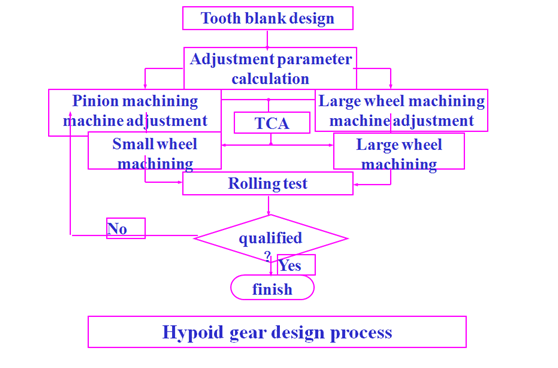Hypoid gear has high strength, and stable movement, and is suitable for transmission with large deceleration, and its tooth ratio can be 10:1, 60:1, or 100:1.
More resources
Hypoid gear advantages
1) The axis of the pinion is offset, which increases the helix Angle of the pinion, resulting in a significant increase in the diameter of the pinion, which can enhance the strength and rigidity of the pinion; And under the same conditions can achieve a larger transmission ratio than the spiral bevel gear.
2) There is relative sliding along the tooth length direction and the tooth height direction, so the tooth surface is worn evenly. After heat treatment, it is also easy to grind, improve the contact area, improve the tooth surface finish, and reduce noise.

Under the same conditions, the hypoid pinion is much larger than the spiral bevel pinion.
3) The overlap coefficient is larger than the spiral bevel gear transmission, the transmission is more stable, and the positive pressure on the tooth surface is small.
4) The offset of the axis position enables the transmission to be arranged in space with greater freedom. The following bias can be used to reduce the center of gravity of the car to increase smoothness; It can also be used to increase the height of the car body and increase the off-road of the car.

Hypoid gear transmission compared with other types of staggered shaft transmission also has some disadvantages:
- Calculation and design are far more complex than other gear pairs, according to Gleason’s method, taking geometric calculation as an example, there are 150 basic formulas, including three iterative calculations (usually iterative three times, sometimes more)
- Compared with the general orthogonal spiral bevel gear, the calculation of cutting teeth adjustment is more complex, and the matching of contact areas is also more difficult.
- High lubrication conditions require special hypoid gear oil.

Due to the bias distance of the large and small wheels, the pressure Angle and curvature of the tooth profile on the two tooth surfaces are not the same, that is, the two tooth surfaces, convex surface, and the concave surface are not symmetrical, which is different from the spiral bevel gear.
Some characteristics of hypoid gear: the longitudinal slip between the tooth surfaces of hypoid gear is far more than that of cylindrical gear and spiral bevel gear, this slip has a great impact on the bearing capacity and tooth surface wear, in most cases mechanical wear, or cause tooth surface bonding, the second failure form is fatigue pitting. To avoid gluing or pitting of the tooth surface, the tooth surface needs to have sufficient hardness, and the contact area should have the appropriate shape, size, and position. Tooth surface lubrication requires a special anti-wear lubricating oil (called “hypoid gear oil”). The problem of lubrication is very important to the operation of the hypoid gear, which determines the bearing capacity of the heavy-duty hypoid gear pair. Under the above conditions, especially after the use of special lubricating oil, at the maximum load and maximum bias, it can be considered that the bearing capacity of hypoid gear is limited only by the bending strength.
Hypoid gear design process

Common machining method of hypoid gear
- Usually, it is represented by three letters, such as HGM, HGT, HFM, and HFT.
- The first letter indicates the type of gear being machined – H(Hypoid Gears), S(Spiral Bevel Gears)
- The second letter indicates the processing method of the large wheel – G(Generated), F(Formate)
- The third letter indicates the machining method of the small wheel – T(Tilt), M(Modified Roll)
Tooth blank design of hypoid gear
- Basic geometry of hypoid gear pairs
- Speed ratio and spiral Angle
- The ultimate pressure Angle and pressure Angle of hypoid gear
- Limit curvature radius and cutter head radius
- Hypoid gear design
1) The pitch cone of hypoid gear is the approximation of a single-leaf hyperboloid, and the two pitch cones of hypoid gear contact tangentially only at node P.
2) For a given transmission ratio, the pitch cone of hypoid gear is not unique, if the helix Angle of the pinion is given, the pitch cone of hypoid gear is uniquely determined. Therefore, if the helix Angle does not meet the requirements, it is satisfied by changing the radius of the pinion r1.
3) Hypoid gear design requires that the limit curvature radius meets the standard cutter size and that the difference between the pressure Angle on both sides of the gear teeth and the limit pressure Angle is equal to the average pressure Angle.
4) The pressure Angle affects the bending strength, the greater the pressure Angle, the higher the bending strength, but the narrower the tooth tip; The spiral Angle affects the axial force, and the larger the spiral Angle, the greater the axial force on the system.
5) Because the hypoid pinion has a larger diameter than the spiral bevel gear pinion under the same conditions, the tooth thickness of the hypoid gear wheel billet does not need to be corrected when designing. If it is considered that the bending strength of the pinion is still low after design, the method of modifying the pinion tooth thickness is actually very simple, just increase the actual tooltip distance of the big wheel, and then recalculate the corresponding tooth base groove width, cutter head and machine tool processing parameters of the pinion. In this way, the tooth thickness of the large wheel decreases a certain value, and the tooth thickness of the small wheel increases the corresponding value.
6) Gleason recommends the addendum height coefficient, which has been corrected. If the addendum height coefficient is further reduced, the bending strength of the pinion will increase, and the tooth will become fatter, but the addendum will become narrower; On the contrary, the bending strength of the large wheel will increase, while the bending strength of the small wheel will decrease.
7) based on the tooth height coefficient recommended by Gleason, the tooth height coefficient can be appropriately increased, and the increase of tooth height can increase the degree of contact.
JHMIM gears are widely used in industrial robots, packaging and printing machinery, spring machines, CNC machine tools, and other industries. Our company can provide high-precision, ultra-quiet, reliable quality gear service for customers from all walks of life!

